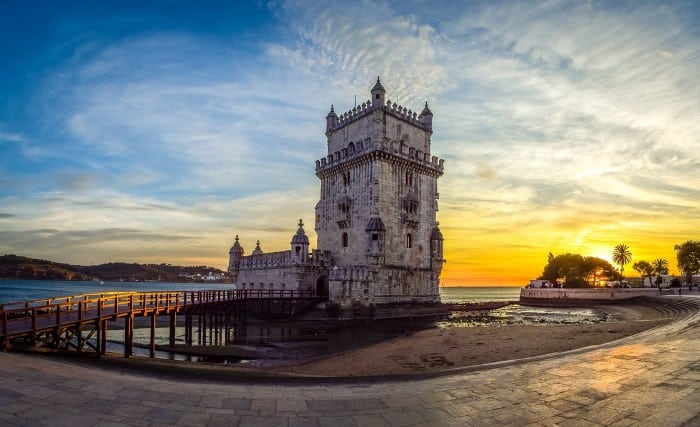Lisbon, Portugal City Break
Lisbon in Portugal is one of the oldest cities in the world and the oldest in Western Europe. Book your next Holiday with us and we give you the best recommendations on what to do and see. All our Holidays and Offers are subject to availability. They are obtained from our partners and suppliers. We carefully choose who we work with, so we can give you the maximum satisfaction. Terms and Conditions Apply. All prices are correct at the time of publishing the holiday or offer. Price From is valid for the cheapest holidays we can get throughout the season. Travel with World Lifetime Journeys!
For holidays in Lisbon please scroll below
WE HAVE HUNDREDS OF OPTIONS IN LISBON
PRICES STARTS FROM ONLY £129
CONTACT US TODAY

Introduction and activities
Lisbon is the capital of sunny Portugal and the largest city in the country with over 552.700 inhabitants. It is located at the point where Tagus River Estuary meets the Atlantic Ocean. On the other hand, as a travel destination, the riverbank city is has rich and varied long history. For example, find everywhere remnants of the colourful past of Lisbon. From the ruins of a Moorish castle on top of a hill to a café on the sidewalk attached to an ancient wall.
Therefore, there are numerous sights and nice activities for everyone. Go to an event of special tourist interest for instance. Or simply visit Lisbon’s numerous historic and cultural attractions. Most importantly, this is one of the oldest cities in the world and the oldest in Western Europe. Above all, it is a better alternative to the modern European capitals such as London, Paris and Rome. Lisbon from Portugal is rightly proud of the role it played during the era of great discovery. The monuments that glorify the voyages of explorers such as Vasco da Gama are among the most important attractions in Lisbon. In short, here you can find something for everyone. So what are you waiting for?
Historic attractions in Lisbon
Certainly, Mosteiro dos Jerónimos is one of the most beautiful places in Lisbon. Jeronimos Monastery is an impressive monument with an important historical and cultural significance. Moreover, it is not only a place of worship, but also a symbol of wealth in the Great Discovery Period. Today, curious people discover the tomb of the great explorer Vasco da Gama in the church of Santa Maria within the monastery. The monastery is one of Lisbon’s most prominent examples of the Portuguese Late Gothic Manueline architecture. It was classified as a UNESCO World Heritage Site, along the nearby Tower of Belém, in 1983.
Castelo de São Jorge is a Moorish castle overlooking the oldest district and historic centre in Lisbon. Sao Jorge Castle is a great choice for the whole family. This is because its giant parapets, an interactive museum and an interesting archaeological site. However, the main attractions of the castle are the superb views you have across Lisbon, Tagus River and the Atlantic Ocean. For more beautiful views, in one of the towers is a periscope that lets you admire a 360-degree panorama of the city.
Torre de Belem is one of the most symbolic buildings in Lisbon. Most importantly it’s a refined expression of the gorgeous Manueline style with discrete elements from various other architectural styles. It is part of the UNESCO World Heritage since 1983 and the symbol of the 16th Century Great Discoveries of Portugal. Completed in 1521, this giant tower boasts a beautifully decorated façade with marine motifs. The architect, Francisco de Arruda, has been working on raising Portuguese fortifications in Morocco, so there are also Moorish influences such as observation towers.
Other attractions in Lisbon
Lisbon Ocenarium is an experience in the ocean depths. For example, discover over 25.000 species of fish, birds, marine mammals and 7 million litres of salt water. Tourists can look at this aquarium at several levels and can admire a wide range of marine animals including different shark species. Moreover, the Oceanarium in Lisbon is one of the biggest due to its design and dimensions. It is the first aquarium to include ocean habitats in a single controlled environment where impressive ocean ecosystems have been recreated. For example, the Antarctic area contains penguins, while on the other hand, the Pacific area has otters and other animals.
National Azulejo Museum (National Tile Museum) is a beautiful museum, that is certainly full of art. Established in 1965 meanwhile became a National Museum in 1980. In addition it has a unique collection of blue ceramic tiles called “azulejo” with fascinating designs. This museum is the only one in Portugal dedicated to this form of art. For example, the permanent collection dates from the Moorish period and is divided into huge panels with elaborate patterns. Madre de Deus church where the museum is located, is fascinating as well. Therefore the interior of this sixteenth-century chapel is one of the most opulent in Portugal. See here superb gold decorations, a 17th-century azuleus and an impressive altar.
Best time to visit Lisbon
Lisbon enjoys a Mediterranean climate. It has one of the warmest winters of any metropolis in Europe, with the average temperature of 15 °C during the day and 8 °C at night from December to February. The typical summer season lasts about four months, from June to September, although also in April temperatures sometimes reach around 25 °C. The best time to visit Lisbon is either from March to May or September to October, because the weather is still warm and there are fewer crowds than in summer. In those seasons, you might also be able to squeeze in a few beach days. Winters in Lisbon are warmer than any other European metropolis.
Why to go in Lisbon
Lisbon is one of the most interesting and unusual European capitals. With a cosmopolitan atmosphere and a wonderful history, Lisbon is a true open-air museum. It has colourful edifices and gorgeous monuments, connected by funiculars that run on the hills amongst the cheerful locals and rhythms of fado. Enjoy tasty pastries, stunning views and fairy-tale castles on a Lisbon getaway.
How to travel in Lisbon
Lisboa Card: Good for most tourist sights as well as bus, tram, funicular and metro travel. Public transport in Lisbon is reliable and good value. The transport network includes Carris (buses, trams, funiculars and lifts) and the Metro.
By bus: Cash fare on the city bus network is €1,80 for any journey. Various pre-paid re-chargeable passes are available, which reduce the single journey one or two zone fare to 1.25 Euros.
By trams / streetcars: The trams are also run by Carris, and are well worth a ride. In the centre, around ALFAMA, the trams rattle up and down the steep narrow streets, and a local perspective of the city can be obtained. Tram 28 is a ‘must’! It connects Martim Moniz with Campo Ourique and passes through the most popular tourist districts. For visitors, this is the classic Lisbon yellow tram journey through the narrow streets of the city. Be aware. This tram is very frequented by pickpockets. So, make sure you do not carry with you valuable items and money!
By lifts/elevators/funiculars: The Elevador de Santa Justa is run by Carris, and offers good views of the city. The three funicular railways of Bica, Glória and Lavra are included in the various passes.
By metro: The Metro is state-run under a company by a different name. The service is frequent, good value and punctual. The flat fare is now €1.40 plus 50 cents for the re-chargeable card on which the ticket is loaded. This card can be used and recharged until it wears out.









